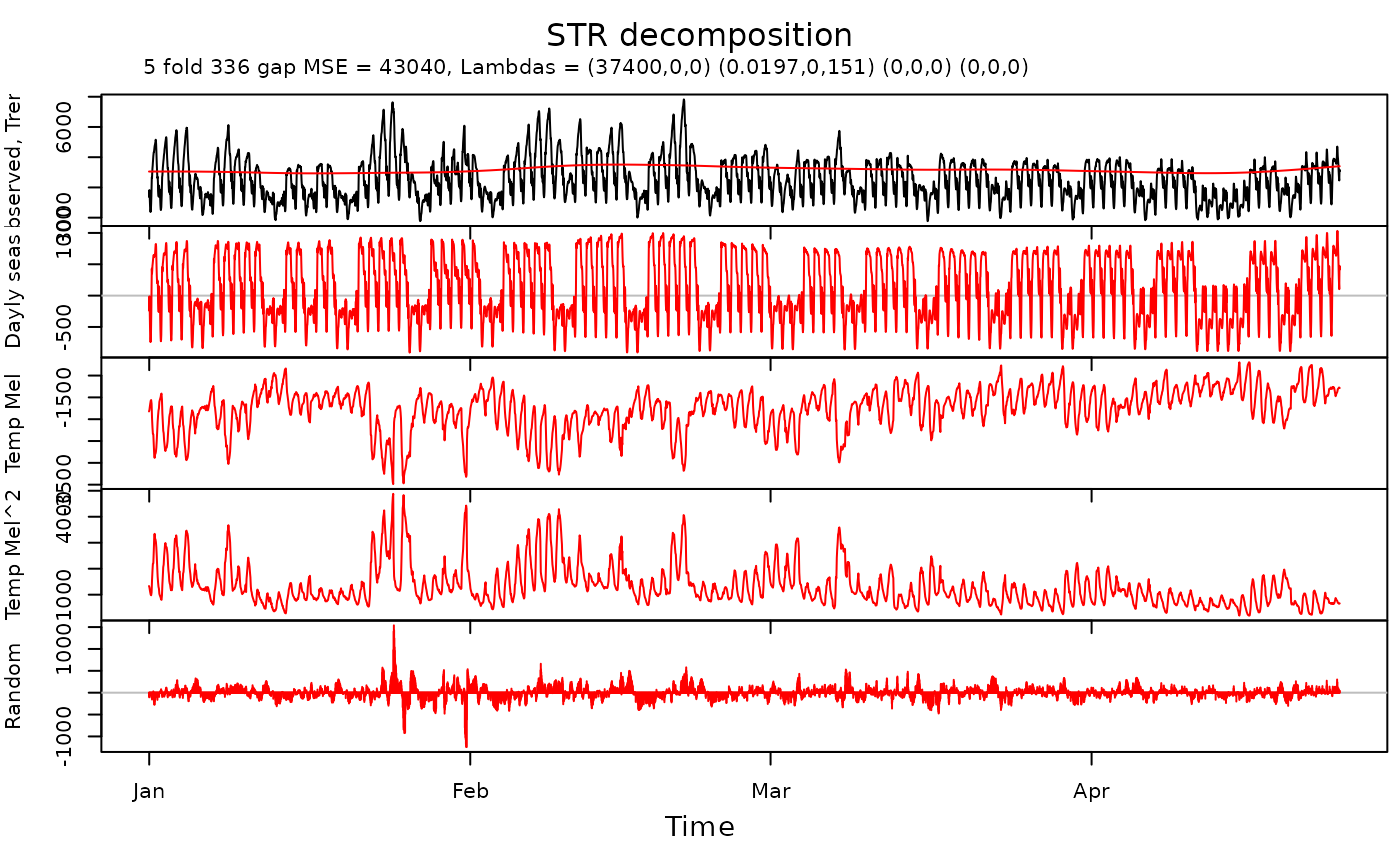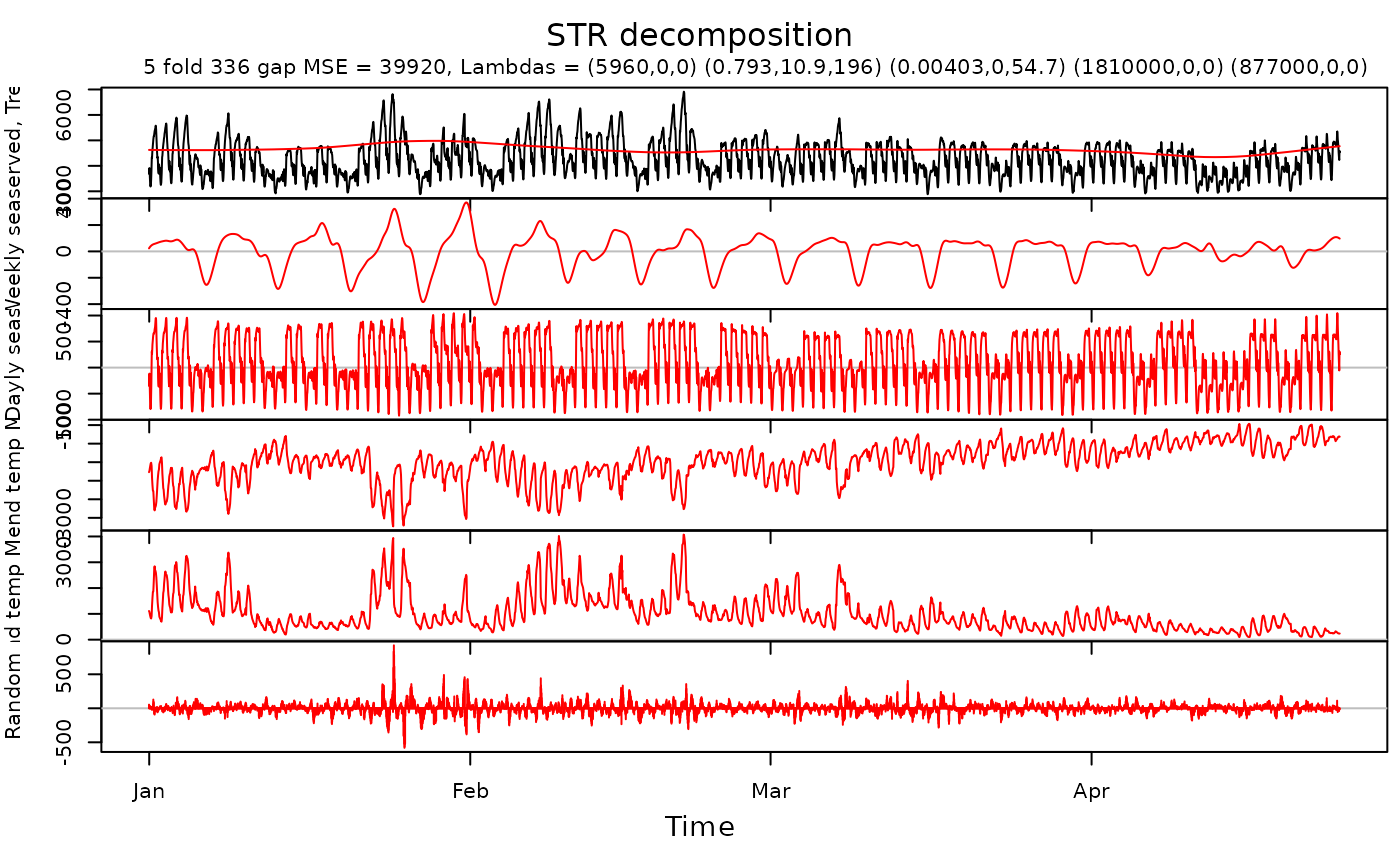Automatic STR decomposition with heuristic search of the parameters
Source:R/heuristicSTR.R
heuristicSTR.RdAutomatically selects parameters (lambda coefficients) for an STR decomposition of time series data.
Heuristic approach can give a better estimate compare to a standard optmisaton methods used in STR.
If a parallel backend is registered for use before STR call,
heuristicSTR will use it for n-fold cross validation computations.
Usage
heuristicSTR(
data,
predictors,
confidence = NULL,
lambdas = NULL,
pattern = extractPattern(predictors),
nFold = 5,
reltol = 0.005,
gapCV = 1,
solver = c("Matrix", "cholesky"),
trace = FALSE,
ratioGap = 1e+12,
relCV = 0.01
)Arguments
- data
Time series or a vector of length L.
- predictors
List of predictors.
According to the paradigm of this implementation, the trend, the seasonal components, the flexible predictors and the seasonal predictors are all presented in the same form (as predictors) and must be described in this list.
Every predictor is a list of the following structures:data – vector of length L (length of input data, see above). For trend or for a seasonal component it is a vector of ones. For a flexible or a seasonal predictor it is a vector of the predictor's data.
times – vector of length L of times of observations.
seasons – vector of length L. It is a vector of ones for a trend or a flexible predictor. It is vector assigning seasons to every observation (for a seasonal component or a seasonal predictor). Seasons can be fractional for observations in between seasons.
timeKnots – vector of times (time knots) where knots are positioned (for a seasonal component or a seasonal predictor a few knots have the same time; every knot is represented by time and season). Usually this vector coincides with times vector described above, or timeKnots is a subset of times vector.
seasonalStructure – describes seasonal topology (which can have complex structure) and seasonal knots.The seasonal topology is described by a list of segments and seasonal knots, which are positioned inside the segments, on borders of the segments or, when they are on on borders, they can connect two or more segments.
seasonalStructure is a list of two elements:segments – a list of vectors representing segments. Each vector must contain two ordered real values which represent left and right borders of a segment. Segments should not intersect (inside same predictor).
sKnots – a list of real values (vectors of length one) or vectors of lengths two or greater (seasonal knots) defining seasons of the knots (every knot is represented by time and season). All real values must belong (be inside or on border of) segments listed in segments. If a few values represent a single seasonal knot then all these values must be on borders of some segments (or a single segment). In this case they represent a seasonal knot which connects a few segments (or both sides of one segment).
lambdas – a vector with three values representing lambda (smoothing) parameters (time-time, season-season, time-season flexibility parameters) for this predictor.
- confidence
A vector of percentiles giving the coverage of confidence intervals. It must be greater than 0 and less than 1. If
NULL, no confidence intervals are produced.- lambdas
An optional parameter. A structure which replaces lambda parameters provided with predictors. It is used as either a starting point for the optimisation of parameters or as the exact model parameters.
- pattern
An optional parameter which has the same structure as
lambdasalthough with a different meaning. All zero values correspond to lambda (smoothing) parameters which will not be estimated.- nFold
An optional parameter setting the number of folds for cross validation.
- reltol
An optional parameter which is passed directly to
optim()when optimising the parameters of the model.- gapCV
An optional parameter defining the length of the sequence of skipped values in the cross validation procedure.
- solver
A vector with two string values. The only supported combinations are: c("Matrix", "cholesky") (default), and c("Matrix", "qr"). The parameter is used to specify a particular library and method to solve the minimisation problem during STR decompositon.
- trace
When
TRUE, tracing is turned on.- ratioGap
Ratio to define hyperparameter bounds for one-dimensional search.
- relCV
Minimum improvement required after all predictors tried. It is used to exit heuristic search of lambda parameters.
Value
A structure containing input and output data.
It is an S3 class STR, which is a list with the following components:
output – contains decomposed data. It is a list of three components:
predictors – a list of components where each component corresponds to the input predictor. Every such component is a list containing the following:
data – fit/forecast for the corresponding predictor (trend, seasonal component, flexible or seasonal predictor).
beta – beta coefficients of the fit of the coresponding predictor.
lower – optional (if requested) matrix of lower bounds of confidence intervals.
upper – optional (if requested) matrix of upper bounds of confidence intervals.
random – a list with one component data, which contains residuals of the model fit.
forecast – a list with two components:
data – fit/forecast for the model.
beta – beta coefficients of the fit.
lower – optional (if requested) matrix of lower bounds of confidence intervals.
upper – optional (if requested) matrix of upper bounds of confidence intervals.
input – input parameters and lambdas used for final calculations.
data – input data.
predictors - input predictors.
lambdas – smoothing parameters used for final calculations (same as input lambdas for STR method).
cvMSE – optional cross validated (leave one out) Mean Squared Error.
optim.CV.MSE or optim.CV.MAE – best cross validated Mean Squared Error or Mean Absolute Error (n-fold) achieved during minimisation procedure.
nFold – the input
nFoldparameter.gapCV – the input
gapCVparameter.method – contains strings
"STR"or"RSTR"depending on used method.
References
Dokumentov, A., and Hyndman, R.J. (2022) STR: Seasonal-Trend decomposition using Regression, INFORMS Journal on Data Science, 1(1), 50-62. https://robjhyndman.com/publications/str/
Examples
# \donttest{
TrendSeasonalStructure <- list(
segments = list(c(0, 1)),
sKnots = list(c(1, 0))
)
WDSeasonalStructure <- list(
segments = list(c(0, 48), c(100, 148)),
sKnots = c(as.list(c(1:47, 101:147)), list(c(0, 48, 100, 148)))
)
TrendSeasons <- rep(1, nrow(electricity))
WDSeasons <- as.vector(electricity[, "WorkingDaySeasonality"])
Data <- as.vector(electricity[, "Consumption"])
Times <- as.vector(electricity[, "Time"])
TempM <- as.vector(electricity[, "Temperature"])
TempM2 <- TempM^2
TrendTimeKnots <- seq(from = head(Times, 1), to = tail(Times, 1), length.out = 116)
SeasonTimeKnots <- seq(from = head(Times, 1), to = tail(Times, 1), length.out = 24)
TrendData <- rep(1, length(Times))
SeasonData <- rep(1, length(Times))
Trend <- list(
name = "Trend",
data = TrendData,
times = Times,
seasons = TrendSeasons,
timeKnots = TrendTimeKnots,
seasonalStructure = TrendSeasonalStructure,
lambdas = c(1500, 0, 0)
)
WDSeason <- list(
name = "Dayly seas",
data = SeasonData,
times = Times,
seasons = WDSeasons,
timeKnots = SeasonTimeKnots,
seasonalStructure = WDSeasonalStructure,
lambdas = c(0.003, 0, 240)
)
StaticTempM <- list(
name = "Temp Mel",
data = TempM,
times = Times,
seasons = NULL,
timeKnots = NULL,
seasonalStructure = NULL,
lambdas = c(0, 0, 0)
)
StaticTempM2 <- list(
name = "Temp Mel^2",
data = TempM2,
times = Times,
seasons = NULL,
timeKnots = NULL,
seasonalStructure = NULL,
lambdas = c(0, 0, 0)
)
Predictors <- list(Trend, WDSeason, StaticTempM, StaticTempM2)
elec.fit <- heuristicSTR(
data = Data,
predictors = Predictors,
gapCV = 48 * 7
)
plot(elec.fit,
xTime = as.Date("2000-01-11") + ((Times - 1) / 48 - 10),
forecastPanels = NULL
)
 ########################################
TrendSeasonalStructure <- list(
segments = list(c(0, 1)),
sKnots = list(c(1, 0))
)
DailySeasonalStructure <- list(
segments = list(c(0, 48)),
sKnots = c(as.list(1:47), list(c(48, 0)))
)
WeeklySeasonalStructure <- list(
segments = list(c(0, 336)),
sKnots = c(as.list(seq(4, 332, 4)), list(c(336, 0)))
)
WDSeasonalStructure <- list(
segments = list(c(0, 48), c(100, 148)),
sKnots = c(as.list(c(1:47, 101:147)), list(c(0, 48, 100, 148)))
)
TrendSeasons <- rep(1, nrow(electricity))
DailySeasons <- as.vector(electricity[, "DailySeasonality"])
WeeklySeasons <- as.vector(electricity[, "WeeklySeasonality"])
WDSeasons <- as.vector(electricity[, "WorkingDaySeasonality"])
Data <- as.vector(electricity[, "Consumption"])
Times <- as.vector(electricity[, "Time"])
TempM <- as.vector(electricity[, "Temperature"])
TempM2 <- TempM^2
TrendTimeKnots <- seq(from = head(Times, 1), to = tail(Times, 1), length.out = 116)
SeasonTimeKnots <- seq(from = head(Times, 1), to = tail(Times, 1), length.out = 24)
SeasonTimeKnots2 <- seq(from = head(Times, 1), to = tail(Times, 1), length.out = 12)
TrendData <- rep(1, length(Times))
SeasonData <- rep(1, length(Times))
Trend <- list(
name = "Trend",
data = TrendData,
times = Times,
seasons = TrendSeasons,
timeKnots = TrendTimeKnots,
seasonalStructure = TrendSeasonalStructure,
lambdas = c(1500, 0, 0)
)
WSeason <- list(
name = "Weekly seas",
data = SeasonData,
times = Times,
seasons = WeeklySeasons,
timeKnots = SeasonTimeKnots2,
seasonalStructure = WeeklySeasonalStructure,
lambdas = c(0.8, 0.6, 100)
)
WDSeason <- list(
name = "Dayly seas",
data = SeasonData,
times = Times,
seasons = WDSeasons,
timeKnots = SeasonTimeKnots,
seasonalStructure = WDSeasonalStructure,
lambdas = c(0.003, 0, 240)
)
TrendTempM <- list(
name = "Trend temp Mel",
data = TempM,
times = Times,
seasons = TrendSeasons,
timeKnots = TrendTimeKnots,
seasonalStructure = TrendSeasonalStructure,
lambdas = c(1e7, 0, 0)
)
TrendTempM2 <- list(
name = "Trend temp Mel^2",
data = TempM2,
times = Times,
seasons = TrendSeasons,
timeKnots = TrendTimeKnots,
seasonalStructure = TrendSeasonalStructure,
lambdas = c(0.01, 0, 0)
) # Starting parameter is too far from the optimal value
Predictors <- list(Trend, WSeason, WDSeason, TrendTempM, TrendTempM2)
elec.fit <- heuristicSTR(
data = Data,
predictors = Predictors,
gapCV = 48 * 7
)
plot(elec.fit,
xTime = as.Date("2000-01-11") + ((Times - 1) / 48 - 10),
forecastPanels = NULL
)
########################################
TrendSeasonalStructure <- list(
segments = list(c(0, 1)),
sKnots = list(c(1, 0))
)
DailySeasonalStructure <- list(
segments = list(c(0, 48)),
sKnots = c(as.list(1:47), list(c(48, 0)))
)
WeeklySeasonalStructure <- list(
segments = list(c(0, 336)),
sKnots = c(as.list(seq(4, 332, 4)), list(c(336, 0)))
)
WDSeasonalStructure <- list(
segments = list(c(0, 48), c(100, 148)),
sKnots = c(as.list(c(1:47, 101:147)), list(c(0, 48, 100, 148)))
)
TrendSeasons <- rep(1, nrow(electricity))
DailySeasons <- as.vector(electricity[, "DailySeasonality"])
WeeklySeasons <- as.vector(electricity[, "WeeklySeasonality"])
WDSeasons <- as.vector(electricity[, "WorkingDaySeasonality"])
Data <- as.vector(electricity[, "Consumption"])
Times <- as.vector(electricity[, "Time"])
TempM <- as.vector(electricity[, "Temperature"])
TempM2 <- TempM^2
TrendTimeKnots <- seq(from = head(Times, 1), to = tail(Times, 1), length.out = 116)
SeasonTimeKnots <- seq(from = head(Times, 1), to = tail(Times, 1), length.out = 24)
SeasonTimeKnots2 <- seq(from = head(Times, 1), to = tail(Times, 1), length.out = 12)
TrendData <- rep(1, length(Times))
SeasonData <- rep(1, length(Times))
Trend <- list(
name = "Trend",
data = TrendData,
times = Times,
seasons = TrendSeasons,
timeKnots = TrendTimeKnots,
seasonalStructure = TrendSeasonalStructure,
lambdas = c(1500, 0, 0)
)
WSeason <- list(
name = "Weekly seas",
data = SeasonData,
times = Times,
seasons = WeeklySeasons,
timeKnots = SeasonTimeKnots2,
seasonalStructure = WeeklySeasonalStructure,
lambdas = c(0.8, 0.6, 100)
)
WDSeason <- list(
name = "Dayly seas",
data = SeasonData,
times = Times,
seasons = WDSeasons,
timeKnots = SeasonTimeKnots,
seasonalStructure = WDSeasonalStructure,
lambdas = c(0.003, 0, 240)
)
TrendTempM <- list(
name = "Trend temp Mel",
data = TempM,
times = Times,
seasons = TrendSeasons,
timeKnots = TrendTimeKnots,
seasonalStructure = TrendSeasonalStructure,
lambdas = c(1e7, 0, 0)
)
TrendTempM2 <- list(
name = "Trend temp Mel^2",
data = TempM2,
times = Times,
seasons = TrendSeasons,
timeKnots = TrendTimeKnots,
seasonalStructure = TrendSeasonalStructure,
lambdas = c(0.01, 0, 0)
) # Starting parameter is too far from the optimal value
Predictors <- list(Trend, WSeason, WDSeason, TrendTempM, TrendTempM2)
elec.fit <- heuristicSTR(
data = Data,
predictors = Predictors,
gapCV = 48 * 7
)
plot(elec.fit,
xTime = as.Date("2000-01-11") + ((Times - 1) / 48 - 10),
forecastPanels = NULL
)
 plotBeta(elec.fit, predictorN = 4)
plotBeta(elec.fit, predictorN = 4)
 plotBeta(elec.fit, predictorN = 5)
plotBeta(elec.fit, predictorN = 5)
 # }
# }